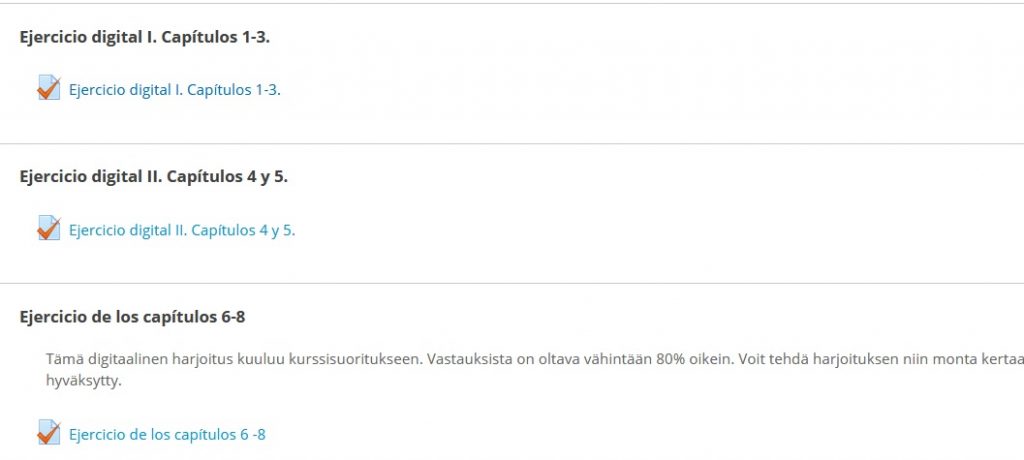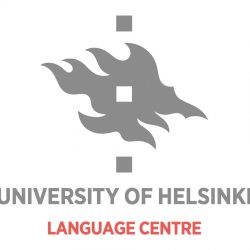Traditionally, A1 (i.e., elementary) courses in Spanish have included two written examinations, an interim examination and an end-of-course examination, which the course teacher has revised and commented on. However, this type of assessment felt fairly one-sided and limited, so we wished to develop assessment into a more formative direction so as to be continuous, provide students with feedback and support their learning. Our aim was also to increase optional elements for students and provide them with a certain degree of freedom. We wished to make our assessment methods more up to date in line with modern pedagogy, and to support lifelong learning as well as self-assessment and peer assessment.

We received inspiration, support and ideas for our development work at the Language Centre’s HILC seminars as well as through discussions with colleagues, thanks to which we began to produce digital and course assignments to replace the traditional interim and end-of-course examinations in our A1-level Spanish courses. Our objective was also to ensure that the assessment is in line with the socio-constructivist approach to learning.
USING THE LANGUAGE FROM THE START
One of our shared goals was for students to look outside the classroom and books and to use the language in as authentic or authentic-feeling situations as possible. Because we can’t offer them a genuine Spanish-language environment in Finland, we simulate situations in which they may find themselves in real life: in one assignment, the students wrote an email to a Spanish-speaking couch surfer, describing their home and neighbourhood and providing information that the visitor might need. In another assignment, the students planned a trip from Helsinki to Madrid, searching for timetables, weather forecasts and event information online and booking tickets and hotel accommodation.
To understand and learn the structures of the language, digital assignments have been posted on Moodle, which the students complete outside the classroom. This is one way to strengthen their ability to adopt and use various structures appropriately. Students also receive immediate feedback on these assignments and can complete them as many times as they like.
STUDENT EXPERIENCES
In the 2016−2017 academic year, we carried out a survey relating to this form of assessment to determine student views. The survey was taken by 76 students. Of them, 95% felt the assessment method was positive and supported their learning, while just 5% had mixed feelings or more critical opinions. Our analysis of the responses revealed four themes: 1) the promotion of self-direction, 2) the use of the language in the “real world”, 3) the increase of deep learning, and 4) a sense of empowerment.
Students also mentioned that the completion of digital and applied assignments allowed them to use their language skills diversely and creatively in communicative situations. When students did not need to feel stress or anxiety about an end-of-course examination, they had fewer negative feelings about learning and the matters they were taught. They said they were more motivated and had more experiences of success. The students also explained that they had been able to concentrate on using the language in various situations because they did not have to study with a view to passing an end-of-course examination. Many said that the new work method reduced stress. In addition, learning and studying were now distributed more evenly rather than taking place only at the end of each course.
We believe that continuous assessment can at best support and develop lifelong and self-directed learning – skills needed in the world of work. The responses also clearly demonstrated the joy and sense of empowerment that students feel when they learned Spanish and found that they could get by in authentic Spanish-language contexts. One student summarised it as follows:
“I used to think that I’m not good at languages. But I have now found out that I don’t learn by trying to cram in a panic for an end-of-course exam. I now feel brave enough to use Spanish even if I make mistakes. I could travel and handle situations even if the other person spoke no English. I would get by in Spanish, definitely.”
Text: Minna Intke-Hernández, Jacqueline Chávez Turro & Gonzalo Hernández Reyes
Read more:
Hernández Reyes, G., Chávez Turro, J. & Intke Hernández, M. 2018. Towards a comprehensive, integrative and formative evaluation process in A1 Spanish courses.

